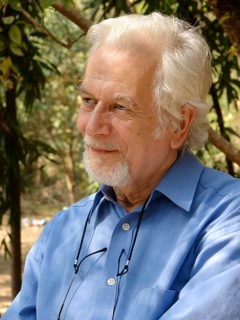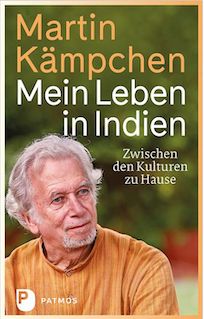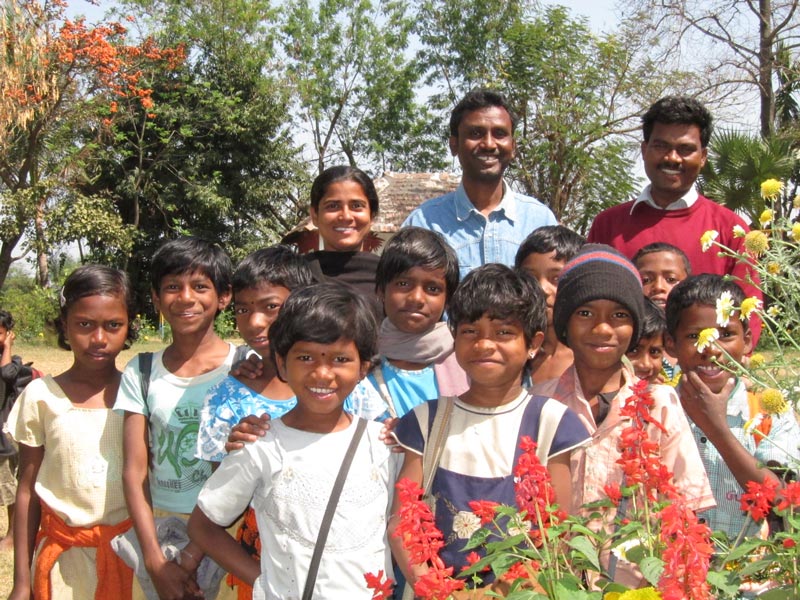
Learn more about this and other murals in West Bengal >>
Excerpt from “Ghosaldanga Adibasi Seva Sangha – Did it make a difference?” by Martin Kämpchen
[Lecture held at Visva-Bharati, Santiniketan, in a seminar on 12th February 2012 evaluating the work of the Ghosaldanga Adibasi Seva Sangha on the occasion of its Silver Jubilee Celebrations. For more information see www.dorfentwicklung-indien.de.]

[…] I tell you this in order to stress that I did not enter Ghosaldanga with the intention of doing social work or research. I visited the village from curiosity, to understand India, to understand human life. I had, even while a student, experimented with and begun a life of fervent simplicity. For example, I never learnt driving a car which is unheard of in Germany. Until today I ride a cycle and do so happily. So when I observed and, to some extent participated in, the life of Ghosaldanga I realized how organically their life blended with the felicity – and the rigours – of nature, and I began to understand how closely related a simple life is with a life in nature. […]
From the beginning, one important area of our work has been nurturing Santal culture. All of our pioneer members feel deeply motivated to preserve, activate and enjoy, propagate and develop Santal tribal culture, especially its dances and songs. Therefore, all the many, many festivals we have organized in Ghosaldanga, Bishnubati and at the RSV school have had that end in mind. Several of us have become veritable experts whose knowledge and experience are sought after in the state. Called by different organizations, cultural groups from our villages have had the opportunity to perform in various cities in West-Bengal, in North and South India, in Germany, Austria, Switzerland and England.
I have been a witness of how many educated Santals wrestle with finding their identity within mainstream Bengali culture. Should they become Westernised, or Bengalised or else discover their value system in Santal culture? Or can a discerning combination of all these become a base for a dignified existence? This has been the subject of intense discussions. Boro has become a writer over this question. Sanyasi Lohar, though not a Santal himself but spending his life in a Santal village, Bishnubati, has developed naïve Santali designs into a sophisticated art-form. Moving outside the Santal villages to present Santal culture without doubt lead to a strengthening of Santal identity and a feeling of self-worth. Read the entire article >>
Source: Ghosaldanga Adibasi Seva Sangha – Did it make a difference? (Lecture by Martin Kämpchen)
Address : http://vortragstexte.martin-kaempchen.de/?page_id=176
Date Visited: Thu Nov 29 2012 15:38:03 GMT+0100 (CET)
Those who had begun the development work in the villages now attended conferences, got to know development projects elsewhere and joined festivals, where they would join the dances and play music. Coming into contact with this larger world strengthened their cultural self-awareness as well as their personal confidence. They developed leadership qualities, which are desperately needed for village work.
Source: “When Santals go abroad: Reflections on an intercultural experiment where representatives from the tribe travelled to Germany” by Martin Kämpchen, The Statesman (India), 15 September 2018
URL: https://www.thestatesman.com/world/santals-go-abroad-1502685147.html
Date Visited: 25 March 2022

Learn more
Ashadullapur Gramin Silpa & Sastha Bidhan Kendra | Sanyasi Lohar
Crafts and visual arts | Masks
Daricha Foundation | Deoal Chitro (wall paintings) | Homepage | YouTube channel
eBook | Background guide for education
Ghosaldanga Bishnubati Adibasi Trust
Santal music CD and DVD by Ghosaldanga Bishnubati Adibasi Trust
Santali language | eBook | A Santali-English dictionary – Archive.org
Video | Roots and Branches: The Lifeworld of an Enlightened Villager in West Bengal
Video | Santali video album “Ale Ato” (Our Village, Part 1 of 2) – West Bengal

Photo © Ludwig Pesch
Learn more about Multi-lingual education >>